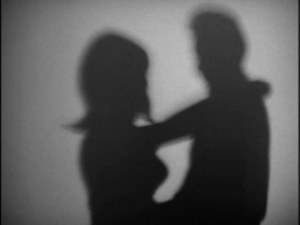 Released in 1966 and directed by Doris Wishman, one of the few women to make a living from directing grindhouse films, My Brother’s Wife is an odd one. Filmed in stark black-and-white and featuring restless camerawork that suggests that the camera is as desperate as the characters in the film, My Brother’s Wife plays out like a wonderfully sordid dream.
Released in 1966 and directed by Doris Wishman, one of the few women to make a living from directing grindhouse films, My Brother’s Wife is an odd one. Filmed in stark black-and-white and featuring restless camerawork that suggests that the camera is as desperate as the characters in the film, My Brother’s Wife plays out like a wonderfully sordid dream.
My Brother’s Wife opens with two men getting into a fight at a pool hall. As they fight, we hear (via the film’s oddly disconnected dialogue) that someone is dead and that one of the men is responsible. In the best tradition of film noir, the rest of the movie is told in flashback.
Frankie (Sam Stewart) is a loser, a drifter who wanders from town to town and who carries a gun in his suitcase. On a whim, he pays a surprise visit to his older brother, Bob (Bob Oran). Bob is everything that Frankie isn’t. Bob is successful, kind, responsible, bald, and married to the much younger Mary (June Roberts). Mary, who is frustrated with Bob’s lack of sexual passion, finds herself attracted to Frankie. Soon, she and Frankie are having an affair. Frankie starts to put pressure on Mary to steal all of Bob’s money and give it to him so that he can leave town.
Mary, of course, assumes that she’s going to be leaving town with Frankie but what she doesn’t know is that Frankie has got another girlfriend. Zena (Darlene Bennett) is Mary’s opposite. Whereas Mary is wracked with guilt over her affair with Frankie, Zena is a prototypical lingerie-clad grindhouse bad girl. However, Zena lives in fear of her lesbian cousin and is just as anxious as Frankie to get her hands on some money and to get out of town…
Doris Wishman was one of the more eccentric grindhouse directors and her trademark surreal aesthetic is on display in My Brother’s Wife. Very little actually happens in this 61-minute film but it remains watchable because Wishman brings so many odd touches to the material that the film could easily be mistaken for a film from David Lynch.
Visually, My Brother’s Wife is a film full of jarring camera angles and restless energy. When Mary complains to Bob about their nonexistent sex life, the camera shows us their reflection in the bedroom mirror before panning over to show the two of them in the flesh before then panning back to their reflection in the mirror. When the film’s characters leave a room, they do it by walking straight towards and occasionally looking directly at the camera. Rarely does the camera ever film anyone straight on. Instead, it always seems to be situated either above or directly below the film’s cast.
Of course, it can be argued that a lot of the film’s aesthetic touches were due less to artistic vision and more to the low-budget realities of grindhouse filmmaking. For instance, Wishman shot the film without sound and the film’s sparse dialogue was dubbed during post-production. As a result, there’s no background noise (which gives the entire film a sparse, ennui-drenched feel) and the tone of the voices delivering the dialogue often feels totally disconnected from the action on-screen.
Of course, the major issue with dubbed films is that the dialogue rarely matches the movement of the lips on-screen. Wishman handles this issue by rarely allowing us to actually see anyone talk. Instead, she shows us people reacting to someone else speaking. Often times, she’ll cut to a shot of someone’s feet while they speak or else the camera will seem to randomly focus on whatever inanimate objects happens to be sharing the room with the people talking. In perhaps the film’s strongest visual, we listen to Mary and Frank have a conversation while we look at their shadows projected on the bedroom wall. It’s all rather dream-like and compulsively watchable.
 Much like David Lynch and the filmmakers of the French New Wave, Doris Wishman built the foundation of her own unique sensibility on B-movie material. The cinematic world of Doris Wishman is one where weak men can’t resist duplicitous women and where everyone — regardless of innocence or guilt — is left punished at the end. In Wishman world, all the men speak in hard-boiled dialogue and you can tell whether a woman is a good girl or a bad girl by what color lingerie she’s wearing. Personally, if I had a time machine, I would love to go back to 1960s New York and audition to be a Doris Wishman bad girl.
Much like David Lynch and the filmmakers of the French New Wave, Doris Wishman built the foundation of her own unique sensibility on B-movie material. The cinematic world of Doris Wishman is one where weak men can’t resist duplicitous women and where everyone — regardless of innocence or guilt — is left punished at the end. In Wishman world, all the men speak in hard-boiled dialogue and you can tell whether a woman is a good girl or a bad girl by what color lingerie she’s wearing. Personally, if I had a time machine, I would love to go back to 1960s New York and audition to be a Doris Wishman bad girl.
Seriously, bad girls have all the fun.
While My Brother’s Wife may not be the best known film in Wishman’s eccentric filmography (that honor would probably go to either Nude on the Moon or Bad Girls Go To Hell), it’s still a valuable example of the Wishman aesthetic.

